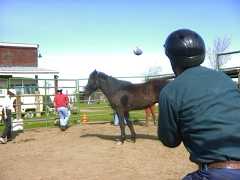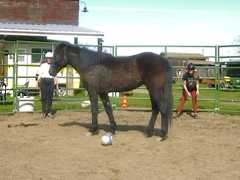Sometimes we'll come across a horse that has particular issues with people.
He may be uncontrollably wary of humans in general. Most often, he is "stuck"
processing humans with one eye and gets very worried when he has to deal with
humans on his "weak" side. Forcing the issue with a one sided horse often
gains poor results since horses learn little when highly stressed. The human
round pen, also known as a Navajo circle, creates an environment where the
horse is passively surrounded by humans and learns to process their presence
in a non-confrontational manner.
Key Points When Setting up
the Human Round Pen
- The horse should not have exhibited aggressive tendencies.
- The round pen should be large enough so that the human circle can
start out wide.
- The humans need to all understand that the object here is not to
directly interact with the horse, but rather indirectly interact
(do things that are not directed towards the animal.)
- The human pen is dynamic and can change shape and dimension according
to the activities taking place and the horse's behavior.
- Each participant needs to constantly observe the horse but not stare
at the horse.
- One person needs to call the activities, similar to a square dance caller.
The participants need to respond in a quiet, flowing and coordinated manner.
- Humans shouldn't approach the horse. The horse will eventually come to the
humans.
- The person "calling" the session should have some predesignated safety strategies
which should be predefined and clearly conveyed to all participants prior to
inviting the horse into the game.
- Identify where the horse would want to go and "nest" if he gets stressed.
- Identify where the participants will move if the horse gets agitated and needs
some time out in his "nesting" spot.
- Don't wear out your welcome or the horse's attention span. If the horse
stops interacting, it's time to give him a break and reassemble the circle
at a later time.
|
An overhead view
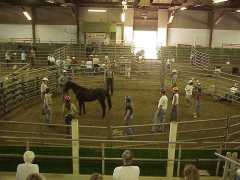
Floor level view
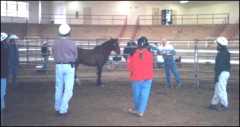
Coming over to be haltered
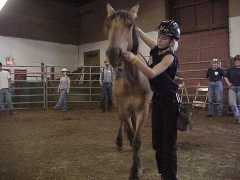
Hugging burros
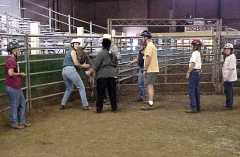
A smaller group still works
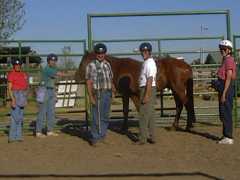
|
|
The important elements here involve safety and attitude. Everyone needs to pay
attention, but everyone also needs to have fun. This should be an exploratory
adventure for both horse and humans; a low key version of a strange horse meeting
up with and bonding with a new herd. The herd discovers what the new horse is
all about and the new horse discovers the herd.
If everyone maintains this attitude and allows the horse to make some decisions, the horse
will eventually try to make friends.
|
Ranger used to be anxious around people
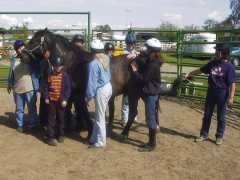
|







